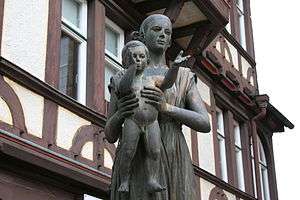Sophie of Thuringia, Duchess of Brabant
| Sophie of Thuringia | |
|---|---|
| Duchess of Brabant and Lothier | |
|
Statue of Sophie of Thuringia, and her son Henry in Marburg | |
| Spouse(s) | Henry II, Duke of Brabant and Lothier |
|
Issue
Henry I, Landgrave of Hesse Elizabeth of Brabant | |
| Noble family | Ludowinger |
| Father | Ludwig IV of Thuringia |
| Mother | St. Elisabeth of Hungary |
| Born | 20 March 1224 |
| Died | 29 May 1275 (aged 51) |
| Buried | Villers Abbey, Brabant |
Sophie of Thuringia (20 March 1224[1] – 29 May 1275) was the second wife and only Duchess consort of Henry II, Duke of Brabant and Lothier. She was the heiress of Hesse which she passed on to her son, Henry upon her retention of the territory following her partial victory in the War of the Thuringian Succession in which she was one of the belligerents.[2] Sophie was the founder of the Brabant dynasty of Hesse.
Family
Sophie was born in Wartburg Castle, near Eisenach in Thuringia, central Germany on 20 March 1224, the eldest daughter and second child of Louis IV of Thuringia and St. Elisabeth of Hungary, daughter of King Andrew II of Hungary and Gertrude of Merania. The Cronica Reinhardsbrunnensis recorded Sophie's birth: 1224 mensis tercio XX die to beata Elisabeth of filiam Sophiam in castro Wartburg.[3] She had an older brother Hermann II, Landgrave of Thuringia and a younger sister, Gertrud who was born posthumously; she entered the Church and later became Abbess of Altenberg. When Sophie was three years old, her father embarked for the Sixth Crusade, and died unexpectedly of a fever on his way to the Holy Land. Her brother Hermann succeeded as landgrave; however, their uncle Henry Raspe acted as his regent. Her mother, following the birth of her posthumous daughter, Gertrud, left Wartburg Castle and went to live in Marburg where she founded a Franciscan hospital for the poor and sick. Sophie and her two siblings were sent away on the orders of their mother's manipulative confessor, Konrad of Marburg. They were placed in Bollenstein Castle, under the supervision of their great-uncle Egbert, Bishop of Bamberg. When Sophie was seven, her mother died, leaving her and her siblings orphans. In 1235, Elisabeth was canonised as a saint. Upon Elisabeth's death, which had occurred in 1231, Henry Raspe assumed control of Thuringia, becoming its de facto landgrave; and Sophie's brother eventually died in 1241, never having reigned.
War of the Thuringian Succession
When Sophie's uncle, Henry Raspe, Landgrave of Thuringia died without issue in 1247, Sophie entered into a dispute over the succession to the Ludowinger territories of Thuringia and Hesse to which she was a claimant; her rivals were her cousin, Henry III, Margrave of Meissen and the Archbishopric of Mainz, which claimed the territories as fiefs of the Archbishop. This dispute led to the War of the Thuringian Succession, which lasted for 17 years. Sophie, who was backed by the Hessian nobility, achieved a partial victory in 1264 as she managed to win Hesse,[4] with her son, Henry succeeding as the first landgrave by right of his mother; whereas her cousin, Henry received Thuringia. The outcome of the dispute was the emergence of Hesse as an independent landgraviate, which eventually became a powerful territorial principality.
Marriage and issue
In 1241 at the age of 17, Sophie married Henry II, Duke of Brabant and Lothier as his second wife. Her marriage was recorded in the Annales Parchenses.[5] She was his only wife to be styled Duchess of Brabant and Lothier, as Henry's first wife Marie of Hohenstaufen had died just six months before he succeeded his father to the dukedom. Together Henry and Sophie had two children:[6]
- Elisabeth of Brabant (1243 – 17 April/9 October 1261), married Albert I, Duke of Brunswick-Luneburg and had no issue.
- Henry I, Landgrave of Hesse "The Child" (24 June 1244 – 21 December 1308), married firstly Adelheid of Brunswick-Luneburg, by whom he had issue, married secondly Mechthild of Cleves, by whom he had additional issue.
Sophie also had six stepchildren from her husband's first marriage to Marie.
She was described as having been an "energetic and courageous woman, proud of her saintly ancestry".[7] She began all her letters and charters with the following: "We, Sophie, duchess of Brabant, daughter of St. Elisabeth".[8]
After the death of her husband, Sophie resided in a castle situated beside the Dijle river in the village of Sint-Agatha-Rode, Brabant.[9]
She died on 29 May 1275 in Marburg, and was buried in Villers Abbey in Brabant. There is a statue representing her and her son Henry in Marburg.
References
- ↑ Charles Cawley, Medieval Lands, Thuringia
- ↑ Cawley, Thuringia
- ↑ Cawley, Thuringia
- ↑ The Catholic Encyclopedia: St. Elizabeth of Hungary
- ↑ Cawley, Thuringia
- ↑ Cawley, Medieval Lands, Brabant
- ↑ Women of History - S, www.abitofhistory.net/html/rhw/s_body.htm, retrieved 13 June 2010
- ↑ Women of History - S
- ↑ Martens, Eric (1978), "Uit Het Verleden van de gemeente Huldenberg" (From the past of the Town of Huldenberg), (in Dutch) Huldenberg, Printed by L. Vanmelle N.V. Gent, No: D/1978/2789
| Royal titles | ||
|---|---|---|
| Preceded by Marie of France |
Duchess of Brabant and Lothier 1240–1248 |
Succeeded by Adelaide of Burgundy |
